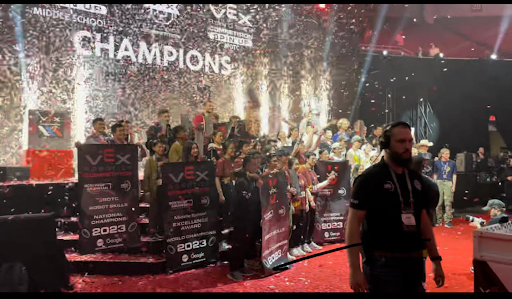
National Paper Airplane Day
by Jordin Lim
National Paper Airplane Day, celebrated each year on May 26th in the United States, is the unofficial observance of a simple, beloved aeronautical toy. This day is commonly celebrated through contests in two basic flight categories: distance and air-time.
Most people are familiar with paper airplanes and enjoy making them frequently. I know that personally, I tend to indulge in making paper airplanes whenever I get bored, but of course never in class (wink).
QUICK TIMELINE OF PAPER AIRPLANE DAY

SCIENCE ACADEMY PAPER AIRPLANE COMPETITION
Here at The Science Academy, Mr. Bradfield’s MakerSpace classes have the wonderful opportunity to participate in Paper Airplane Day at school. Every year, the class goes out to the quad where an intense paper airplane contest is carried out.
There were many creative attempts at winning this competition, with someone actually wrapping up a basketball and claiming it to be their paper airplane. I even caught glimpses of a torpedo-like airplane shooting through the skies.
Overall, the best paper airplane was created by Sutthidol Chainamnaris (8th grade) with a plane that achieved a distance of 94.5 feet!
Will you make the award-winning plane next year? Will your airplane come out on top? Better start practicing now!



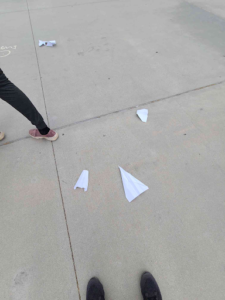
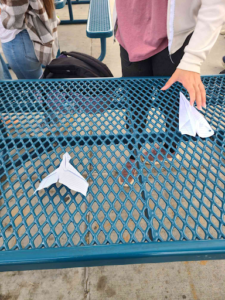
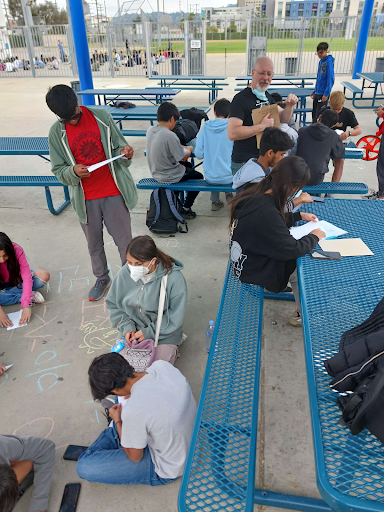
FURTHER INFORMATION ON PAPER AIRPLANES
Do you want to know the science behind paper airplanes? Watch the video below.
Do you want to make some fun paper airplanes? Check out the videos below.
This channel also has really great videos on paper airplanes:
https://youtube.com/@funpaperairplanes)
Read More
Robotics Champions
By Maleeya Mickelson and Milan Riley
Science Academy is the proud home to a world-renowned Robotics Club! Our teams have received many awards over the years and have brought back multiple wins, not only from local VEX Robotics Competitions (VRC), but from State and even World competitions. This year has continued to showcase the many talents of our students with an especially successful season.
The 2022-2023 Robotics Teams consisted of between two to five members, who worked together on their planning and execution by meeting at least twice a week to get ready for competitions throughout the season. As part of their dedication to the Robotics Program and in preparation for their competitions, teams often met in Science Academy’s on-campus Robotics Lab after school on Tuesdays and Wednesdays. During that same time, advanced robotics mentors provided assistance to students as well.
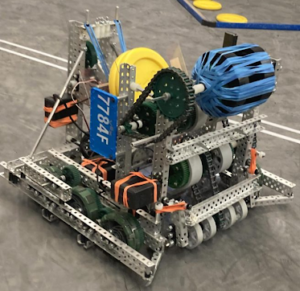 Example of 2023 VEX VRC robot
Example of 2023 VEX VRC robot
Each team strived to build a robot that could compete in all aspects of the game. Every year the game changes, meaning the teams have to create new robots. This year’s game, called “Spin Up”, challenged two alliances, Red and Blue, each made up of two teams. The game started off with a 15-second autonomous period — a period when the two teams used code already pre-made to score as many points as possible. The alliance who scored the most points during this time received a 10-point bonus. The game then moved onto a 1-minute and 45-second long driver control period, where alliances once again had to score as many points as possible. Different ways to score points included shooting discs into the high goal (5 points), getting discs into the low goal (1 point), or spinning the rollers on the field (10 points). During the last 10-seconds of the match, teams could release their robot’s expansions (often made out of string) in order to score even more points by covering the tiles on the field. Every tile the team covered at the end of the game scored them another 3 points.
 The 2023 challenge arena
The 2023 challenge arena
Teams competed in many competitions this season. An overall win at one of the local competitions, as well as winning certain awards that vary from competition to competition could qualify them for the States competitions. At competitions, teams went through multiple rounds with randomly picked alliances in order to determine seeding for the elimination round. After a certain number of rounds, teams then chose their own alliances for playoffs and eliminations. Teams higher on the seeding chart received the chance to pick an alliance sooner. The 16 alliances created, consisting of a total of 32 teams, then went on to compete for the championship.
Teams also could have qualified for State competitions via another aspect of VEX Robotics Competitions known as Skills. At each competition, teams received six tries to score as many points as possible either autonomously or by driver control. They were allowed three tries for each method. Autonomous and driver control during Skills were very similar to during matches because the teams used the same methods to score points; however, teams did not have to deal with defense from their opponent or defending themselves because they were the only ones on the field.
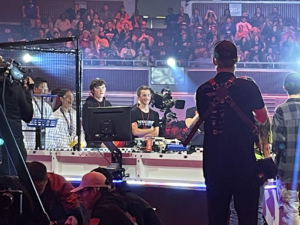 Middle School Champions during the competition
Middle School Champions during the competition
Another large component of the competition focused on the creation and organization of the team’s engineering notebook. Throughout the season, teams recorded their progress and all the work they’ve done on their robots, from their first prototype to their final design after many adjustments and long hours of trial and error. The purpose of the notebook is to show the judges the team’s thinking, processes and their progress. Without a good engineering notebook, teams cannot win many of the awards.
This year, VEX held two State competitions, split into middle school and high school, for our region, one in San Diego and another in Los Angeles. Teams from the Science Academy won both competitions (3324U & 3324B), qualifying them for Worlds. Other teams also qualified for Worlds either by having a high score in Skills or by the following awards: Excellence Award, Design Award, Robot Skills Champions, Innovate Award, Amaze Award, Think Award, or Build Award.
 Team 3324B at a state competition
Team 3324B at a state competition
The VEX Robotics World Championship was held in Dallas, Texas at the Kay Bailey Hutchison Convention Center Dallas from April 25 to May 5. The event was split into competitions for middle school and high school. Two of our high school teams competed from April 25 to April 27 and of our eight middle school teams participated from April 27 to April 29. Due to the large number of teams present at the World’s competition, VEX split the teams into different divisions. Within each division, each team participated in a mini competition, where the winners from each division advanced to the final elimination rounds in the so-called “Dome.” These rounds took place with thousands of people watching.
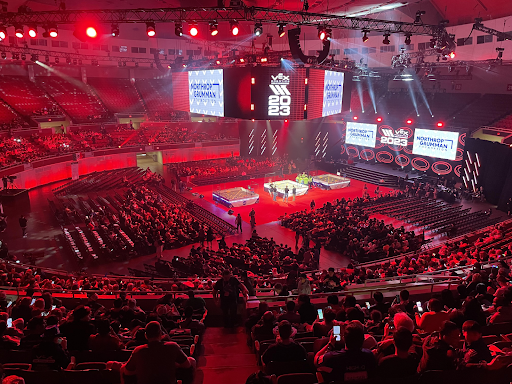 2023 Vex Robotics Competition
2023 Vex Robotics Competition
After a fierce competition between Science Academy’s Team 3324U (aka Supernova Team Hydra) and their alliance Shanghai’s Team 9123X against West Vancouver’s Team 10012W and their alliance Shanghai’s Team 9123C, Supernova Team Hydra and their alliance emerged triumphantly as the VEX VRC Middle School World Champions 2023! Despite being a first-year team, two eighth graders, Nicholas Mandreyka and Eero Wolfe, successfully created a robot worthy of a world championship. Congratulations to them!
The following Science Academy teams also won awards in their divisions as listed:
3324U Nicholas Mandreyka and Eero Wolfe Think Award
3324B Shivaan Nigam, Liam Cahill and Lily Kelsay Amaze Award
3324Y Aidan Limketkai, Gabe Cooper and Aaron Park Build Award
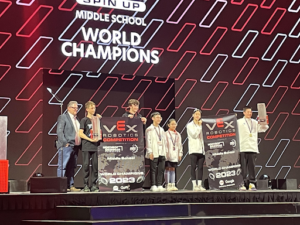
During the World’s competition, VEX also revealed the challenge for the 2023-24 season: Over Under. The goal of Over Under is to score as many points as possible by performing actions such as placing the game element (tri-balls) under goals or elevating the robot on a post at the end of the game.
Congratulations to all teams that participated in the 2022-23 VEX robotics season! Each and every team did a great job and has made the Science Academy very proud. A special congratulations to the members of 3324U, 3324B, and 3324Y for their accomplishments at the World Championship. Good luck to all teams competing in the 2023-24 season!
After the excitement of the World Championship, teammates Eero Wolfe and Nicholas Mandryka, the middle school winners of the 2023 VEX Robotics Competition, sat down with Milan Riley for an interview looking back over this momentous competition season:
1. What were your goals for this competition?
“Our goal for this competition was to win our division [500 teams are split into 6 divisions].”
2. What have you learned from past competitions and how are you putting that info to use now?
“What we have learned from past competitions was that ranking high before eliminations and alliance selection is important, as well as warming up before each match.”
3. What specific skills have you and your team been working on to prepare?
“Specific skills that our team has worked on to prepare was my driving because at high levels, robots are equally matched as they can score points at almost 100% efficiency and it comes down to the driving to determine who wins.”
4. What modifications have you had to make to your robot(s)?
“Some modifications that we have made to our robot was to have it shoot very fast so that when being defended, we can shoot all of our disks before being blocked. We also made sure that our expansion – we try to cover as many tiles as possible using string that is launched from the robot – does not fire out of the field so that we are not disqualified from the tournament.”
5. What were some highlights from the competition?
“Some highlights for the competition were of course winning it, but also after and during the competition when all of the teams were together having fun and supporting each other.”
6. Why do you think you guys did so well this year?
“Some reasons that we did so well this season was that we had great mentors and sister teams that helped us so much and motivated us to try so hard.”
7. What are you looking forward to working on in the future?
“We are looking forward next year to competing in high school with new members on the team and being able to help the new teams that were once us.”
8. What capabilities are you looking forward to the robotics world developing in the future in the competition world? What about in terms of real-world applications?
“As new technology like more efficient electronics become accessible, teams will be able to do even more and create amazing robots that can compete at levels unimaginable right now. VEX robotics takes a lot of real world robotics concepts and incorporates them into the competition, meaning that as technology becomes better, so will the robotics in the real world.”

